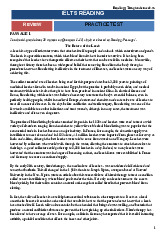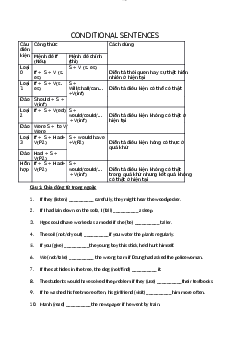


Preview text:
Mark the letter A, B, C or D to indicate the word whose underlined part is pronounced differently from that of the rest in each of the following questions:
C. limit |
- A. right B. lifeD. childbearing
|
|
- A. glove B. above C.
wife |
- A. B. who C. two D. power
established |
ulture |
- A. believed B. C. considered D. controlled 5. A. century B. cC. society D. civilization
Choose the best option to complete each of the following sentences.
6. It is considered women are suited for________ childbearing and homemaking rather than social activities.
A. a B. an C. the D. Ø
7. ________ up! The bus is coming. | |
A. Wash B. Put C. Wake 8. Because of heavy rain, the game was ________ for a few days. | D. Hurry |
A. take out B. put off C. set up | D. gotten away |
- Tom: “I think married women should not go to work.” Cindy: “________ It’s too boring to be housewives all their lives”.
- Perhaps, I’m not sure B. I can’t agree with you moreC. That’s right D. I don’t agree
- Go over that report again before we submit it.
- Dictate B. Print C. Read carefully D. Type
- Many women are interested in ________ issues nowadays.
- politic B. political C. politics D. politician
- Who is ________ after the department while you are away?
- getting B. running C. taking D. looking
- In the past, women were economically ________ on their husbands or fathers.
A. dependent B. reliable C. expected 14. Salaries have not ________ inflation in the last few years. | D. demanded |
A. put up with B. taken up on C. kept up with 15. Don’t you believe in ________ between men and women? | D. done out of |
A. equal B. equality C. equalize | D. equalizer |
- The bomb ________ with a loud bang which could be heard all over the town.
- went on B. went down C. went over D. went off
- ________ history, women have always aimed for a recognized place in society.
- During B. In C. Throughout D. For
- Thanks to the women’s liberation, women can take part in ________ activities.
- social B. society C. socially D. socialize
- His parents died when he was small and he was ________ by his grandmother and aunt.
- grown in B. helped along C. taken D. brought up
- It is against the law to ________ on the basis of sex, age, marital status or race.
- suit B. discriminate C. believe D. gain
- I don’t know how they live now. I have lost ________with them since they moved to HCM City.
- money B. address C. communication D. contact
- Nowadays women can contribute ________ the scientific and social development.
- for B. to C. in D. at
- Education is recognized as ________ essential need for achieving equality in most walks of life.
- a B. an C. the D. Ø
- If you do not understand the word “superstitious”, look it up in the dictionary.
- find its meaning B. write it C. draw it D. note it
- My alarm clock ________ off in the middle of the night and ________ me up.
- went/ turned B. went/ woke C. woke/ went D. woke/ turned
- Outdoor ________ are good for children and teenagers.
- actors B. actions C. activities D. acts
A. to/at B. with/to C. to/about 28. Put your shoes ________, it’s too cold to walk around barefoot. | D. with/ to |
A. off B. up C. on 29. The woman sitting opposite me on the train kept ________ at me. | D. away |
A. to stare B. stare C. staring | D. stared |
- There have been significant changes in women’s lives since the women’s liberation movement.
A. controlled B. economic C. important D. natural
Mark the underlined part that needs correction.
- After Mary had had a lunch and taken a map, she hurried up to the lecture hall again. Lunch
- Oh no! We’ve run out petrol and the nearest filling station is ten miles away.Run out of
- This dish tastes like it has meat in it, but it consists with vegetable. Of
- Women’s movements ensure the full education, develop and advancement of women.development
- The Japanese are accustomed to take their shoes off when they enter their houses.to taking
Mark the letter A, B, C or D to indicate the sentence which is closest in meaning to the given one.
- It is argued that women cannot come to a decision in all matters. A. It is argued that women cannot make up in all matters.
- It is argued that women cannot make off in all matters.
- It is argued that women cannot make for their mind in all matters.
D. It is argued that women cannot | make up their mind | in all matters. |
- Mothers have to educate and train their children to be good members for society. A. Mothers have to bring round their children to be good members for society.
- Mothers have to bring in their children to be good members for society.
C. Mothers have to | bring up their children | to be good members for society. |
D. Mothers have to bring about their children to be good members for society.
- It’s possible that we won’t take part in the match this weekend. A. We will probably take part in the match this weekend.
- We will not take part in the match this weekend.
C. We | may not | take part in the match this weekend. |
D. We must not take part in the match this weekend.
- The manager has been responsible for his work in the office.
A. The work in the office has been responsible for the manager.
B. The manager has | taken on | his work in the office. |
- The manager has taken up his work in the office.
- The work in the office has made the manager responsible.
- Do you have a good relationship with neighbors? A. Are you getting with your neighbors?
- Are you going along with your neighbors?
C. Are you | getting on well | with your neighbors? |
D. Are you getting along with your neighbors?
Read the following passage and mark the letter A, B, C or D to indicate the correct answer to each of the questions from 41to 45.
In the 1960’s, the US went through a social revolution commonly referred to as The Women’s Liberation Movement. One of the goals of this movement was to promote the idea that women are equal to men in their ability to learn and to succeed in almost any occupation. The movement has benefited women in many ways, especially in terms of job opportunity and advancement. But it has also created great confusion regarding manners. Formerly, men were considered the stronger and the dominant sex, so they adopt a protective attitude toward the so-called weaker sex. That meant helping women on and off with their coats, lighting their cigarettes, opening doors for them, allowing them to exit from elevators first, and so on. Today, American women do not consider themselves the weaker sex and do not generally feel in need of male protection. Most men
THE SECOND SEMESTER
continue to perform the traditional courtesies, but both sexes are more casual about them. If a man does not help his girlfriend into or out of her chair in a restaurant, no one will think he is rude.
- The Women’s Liberation Movement is a ________.
- political revolution B. social revolution C. cultural revolution D. economic revolution
- One of the goals of this movement was ________.
- to promote the idea that women are equal to men on every aspect
- to promote the idea that women do not need men
- to promote the idea that women are superior to menD. to promote the idea that women are the stronger sex
- The Women’s Liberation Movement ________.
- has no effect on women B. has no effect on men C. makes women uncomfortable D. provides women with benefit
- In former days, ________.
- men paid no attention to women
- men regarded women as the lower class
- men adopted a protective attitude toward women
- men were equal to women
- If a man does not help his girlfriend into or out of her chair in a restaurant ________.
- he is considered to be rude B. he is not thought to be rude
C. he is polite D. he is impolite
Read the following passage and mark the letter A, B, C, or D to indicate the correct word for each of the blanks from 46 to 50.
Today, many men who work in the US have a female boss. Men who come from countries in (36)_____ the woman’s place is still in the home may (37)_____ it difficult to take orders from a woman. But in the US, 44% of the force is female, and many women are judges, doctors, company presidents, college presidents and so on. It is (38)_____ for men to respect a person who holds a position of responsibility and authority, whether that person is male (39)_____female. To treat a woman as inferior (40)_____ she is female is not only insulting but also out of step with contemporary American culture.
- A. that B. where C. which D. there
- A. find B. have C. get D. take
- A. possibly B. important C. independent D. militant
- A. and B. with C. of D. or
- A. though B. so that C. just because D. that



